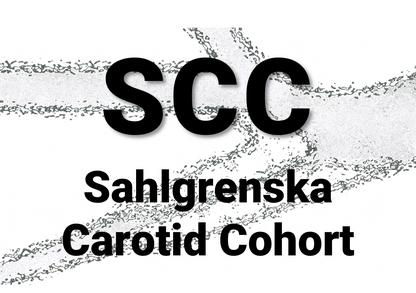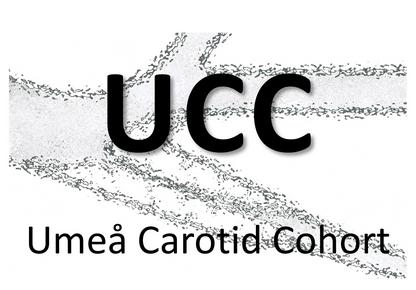
Clinical carotid stenosis research
Short description
Our research focus on atherosclerosis in the frontal two neck arteries (carotid arteries), a well-known cause of stroke. We focus on diagnostics, pathophysiology, prognosis and management of stenoses (severe atherosclerosis) using various methods. The research is performed in close collaborations between neurology, vascular surgery, radiology and clinical physiology. Our current main effort is about novel management for patients with the most severe third of stenoses, called “near-occlusion”.
Background
Carotid stenosis is atherosclerosis of the anterior cervical arteries (carotid arteries). Carotid stenosis is a common cause of stroke, TIA and amaurosis fugax (loss of vision in one eye). Internationally, there are several specializations within carotid stenosis research. What we mainly do is clinical research on those with at least a moderate degree of stenosis (≥50%) who have recently suffered a relevant event (symptomatic stenosis).
The clinical carotid stenosis research project is a broad research project that contains many similar sub-projects over a long period of time. The project began at Umeå University in 2006 and at Sahlgrenska in 2010, and until 2023 has included approximately 2000 participants in eleven different sub-projects, and we have carried out some register-based research. Over the years, several younger researchers have become senior researchers and senior researchers have passed the baton to them. 2023 was a pivotal year for several sub-projects and large parts of the research project changed from shared practical residence in both Umeå and Sahlgrenska to only Sahlgrenska, but the research will continue in both locations for the next few years.
Our most important findings to date
- Shortening of time between presenting event and surgery and risk of recurrent stroke before surgery. We have seen a high risk especially in those with stroke and TIA (not amaurosis fugax), even with a moderate degree of stenosis (50-69%).
- Increased operative risks and logistical problems with very early carotid surgery.
- Brought life to and is an international leader in the research field of near-occlusion. We have carried out most of the international research on prognosis, diagnostics and epidemiology and coined current nomenclature.
We are the most well-cited Swedish research group in international guidelines on carotid stenosis and the most internationally well-cited research group on near-occlusion.
Ongoing research
Ongoing research has 3 foci and 3 major data collections – all are clinical material on carotid stenosis. This is done in close interprofessional collaboration between, above all, neurology, vascular surgery, neuroradiology and clinical physiology, as well as with biomarker expert groups. This is done in both local, national and international collaborations for various issues.
Current foci
1) Near-occlusion. These are the most severe third of carotid stenoses which, unlike conventional stenoses, cause the artery beyond the stenosis to decrease in size (reduced diameter). Near-occlusions are difficult to diagnose, misunderstood and poorly managed - but simple solutions are lacking. Research focuses on improving diagnostics, pathophysiological understanding, prognostic tools and management of symptomatic near-occlusion. The aim is to, in the long term, improve the management of patients who suffer from stroke, TIA or amaurosis fugax from carotid near-occlusion. As near-occlusions are a common subset of carotid stenosis, this is a relevant issue.
2) Other clinical analyzes of symptomatic carotid stenosis. Here, the materials we have collected over a long period of time are used to answer questions that others have difficulty answering. We have an advantage as our studies are based on investigations before surgery (and can therefore also include those who do not undergo surgery) and a lot of resources have been put into properly documenting all events before surgery. In contrast, much of carotid research is done only in patients who undergo carotid revascularization and with poorer data quality. Examples of current issues are the possible effect of thrombolysis treatment on the risk of early relapse, defining clinical instability and its impact on surgical risk, and trying to understand the cause of well-known clinical differences between amaurosis fugax and TIA/stroke.
3) Biomarker analyses. We carry out several biomarker analyzes of both saved blood and carotid tissue from surgeries. Our focus is primarily on trying to understand clinical relationships and differences in prognosis between patient groups from a biomarker perspective - with the hope of being able to improve clinical management in the future.

Current major data collections
1) Umeå Carotid Cohort: Collected approximately 400 patients with carotid stenosis in Umeå between 2018-2022. These patients were examined with many different research methods, some for the first time. Currently, this is the main material for foci #1 and #3 and an important part for focus #2.
2) Merger analyses. Analyzes of combined data from collection #1 and predecessor collection #1 (almost 1000 patients with symptomatic carotid stenosis). Contains almost only clinical variables, few research method variables. Over time, collection #3 can also be added and then the amount of research method variables increases. This material is primarily used for focus #2.
3) Sahlgrenska Carotid Cohort: Planned data collection starting in 2024 which continues indefinitely. This is the main material of the future. This is rather a research infrastructure that runs over time where three different types of substudies are planned:
- Study the orderly introduction of clinical methods that has passed the bar of sufficient evidence for clinical use, such as dual antiplatelet treatment before carotid surgery, intraoperative monitoring and the best diagnostic methods of near-occlusions developed in the Umeå Carotid Cohort.
- Specific substudies of treatments (phase II or III) or novel imaging techniques with separate ethical reviews and consent. Several ideas are in the pipeline, and the next planned substudy is about novel imaging methods.
- Various questions for which patients with carotid stenosis (pronounced and relatively easily investigated atherosclerosis) are suitable for research, such as physical activity and biomarkers.
Recruitment
We are constantly looking for partners. Right now, we are looking for:
- Research groups with biomarker expertise who want to test their methodology on our material
- Post-docs with relevant experience of clinical research in carotid stenosis (various basic professions) or related fields and preferably own funding.


Collaboration
- Department of Clinical Sciences, Umeå University (External link)
- Biomedical Engineering, Umeå University (External link)
- Research group Jern, Gothenburg University (External link)
- Research group Hedin, Karolinska Institutet (External link)
- Research group Kelly, University College Dublin, Ireland (External link)
- Research group Saba, Università di Cagliari, Italy (External link)


